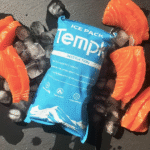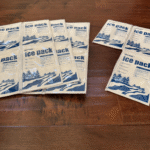Viajar com itens perecíveis requer planejamento, E o gelo seco oferece uma maneira segura de manter os itens congelados durante os vôos. A resposta curta é sim; you can bring dry ice on a plane. No entanto, there are strict regulations to ensure safety. This guide explores the rules for transporting dry ice in 2025, including packaging, rotulagem, and the latest trends to make your journey smoother and safer.
-
Dry Ice Weight and Labeling Rules: Learn about the 2.5 kg limit, proper labeling, and packaging guidelines.
-
Packing Dry Ice for Safe Air Travel: Step-by-step tips on how to pack your dry ice effectively.
-
Erros comuns para evitar: Discover the common errors that could result in your dry ice being confiscated.
-
Alternativas ao gelo seco: Explore other cooling options like gel packs and phase-change materials.
-
2025 Innovations in Cold Chain Travel: Understand the latest trends in air travel and cold storage technology.
Why Is Dry Ice So Popular for Air Travel?
Gelo seco, ou dióxido de carbono sólido, has a sublimation point of -109°F (-78.5°C), making it an ideal solution for keeping items frozen without creating a mess. Ao contrário do gelo regular, it doesn’t leave liquid residue, and it keeps things frozen much longer. No entanto, the extreme cold and the gas it releases can pose certain risks, which is why its transport on planes is regulated by the FAA and TSA.
Risks Associated with Dry Ice
-
Perigo de asfixia: O gelo seco sublima em gás dióxido de carbono, que pode deslocar o oxigênio, leading to dizziness, unconsciousness, or even suffocation in confined spaces if not vented properly.
-
Overpressurization: If dry ice is sealed in an airtight container, the gas expansion could cause the container to rupture violently.
-
Frostbite/Burns: Dry ice can cause severe burns if it comes into direct contact with skin, requiring protective gloves when handling.
How Much Dry Ice Can You Bring on a Plane?
Em 2025, the TSA and FAA allow passengers to carry up to 5.5 libras (2.5 kg) of dry ice in both carry-on and checked luggage, as long as the packaging allows gas to escape. Excedendo o 2.5 kg limit means the dry ice must be shipped as cargo, subject to stricter regulations.
Dry Ice in Carry-On vs. Bagagem despachada
Both carry-on and checked baggage are permissible for transporting dry ice. No entanto, you need to ensure the container is vented and labeled according to regulations.
| Baggage Type | Max Weight | Requisitos de embalagem | Key Action |
|---|---|---|---|
| Carry-On | 2.5 kg (5.5 libras) | Ventilado, rotulado “Gelo Seco” | Declare at check-in |
| Verificado | 2.5 kg (5.5 libras) | Ventilado, rotulado “Gelo Seco” | Declare at check-in |
| Carga | Varia | Must meet IATA requirements | Special approval |
Why Ventilation is Crucial
Sem ventilação adequada, the carbon dioxide gas released by the dry ice can build up pressure inside the container, potentially causing it to rupture. Always use a container with vents or loosable lids to allow the gas to escape. Some containers, such as soft coolers or styrofoam boxes, may not meet the required safety standards due to their inability to vent effectively.
How to Pack Dry Ice for Safe Air Travel
Packing dry ice properly is essential to ensure both safety and compliance with regulations.
Step-by-Step Packing Tips:
-
Escolha o contêiner certo: Use a hardside cooler or insulated box that has vents. Avoid airtight containers like styrofoam coolers.
-
Pre-Chill the Container: This helps reduce the sublimation rate of dry ice, keeping it colder for longer.
-
Wrap and Position the Dry Ice: Wrap the dry ice in paper or cloth to protect your hands and help slow the sublimation process. Place it on top of your perishable items, enquanto o ar frio desce.
-
Leave Space for Gas Venting: Never pack the container too full. Leave some airspace for proper ventilation.
-
Rotule o pacote: Clearly label the container with “Dry Ice” or “Carbon Dioxide, Solid” and include the net weight.
Packing Material Comparison
| Material/Container | Venting Capability | Cold Tolerance | Suitability for Air Travel |
|---|---|---|---|
| Rotomolded Mini Cooler | Excelente (screw-crack lid) | Excelente (-109°F) | Best option for long holds |
| High-Density Polyethylene Mailer Box | Bom (pre-drilled ports) | Bom (viagens curtas) | Suitable for smaller shipments |
| Smart PCM Cooler | Excelente (automatic valve) | Bom (adjustable range) | Long hold time with monitoring |
| Soft Fabric Cooler Bag | Limited (may trap gas) | Poor (may crack) | Avoid for dry ice transport |
2025 Trends in Dry Ice Transportation
Innovations in Cold Chain Travel:
À medida que a indústria da cadeia fria evolui, new trends in packaging and transportation are emerging, incluindo:
-
Sensores inteligentes: Devices that monitor temperature, umidade, and gas release in real-time, ensuring better management during transit.
-
Blockchain Technology: Enhancing transparency in the tracking of dry ice shipments for better quality control and dispute resolution.
-
Embalagens ecológicas: The shift towards sustainable materials, such as biodegradable coolers and packaging, reduces environmental impact.
O que isso significa para você:
These trends suggest that air travel with dry ice will become safer, mais eficiente, and more environmentally friendly, thanks to innovations in logistics technology and packaging solutions.
Perguntas frequentes: Common Questions About Dry Ice in Air Travel
P: Can I bring dry ice in my carry-on bag?
Sim, you can bring up to 2.5 kg (5.5 libras) of dry ice in your carry-on bag, provided the container vents and is clearly labeled.
P: What happens if I don’t get airline approval?
Without airline approval, you risk your dry ice being confiscated at the security checkpoint, ou pior, being delayed or fined.
P: Como faço para descartar restos de gelo seco?
Always allow dry ice to sublimate in a well-ventilated outdoor area. Never dispose of it in sinks or toilets as the extreme cold can damage plumbing.
Conclusão e recomendações
Traveling with dry ice is possible, but it requires careful planning to avoid safety hazards and comply with regulations. Ensure your container is properly vented, rotulado, and that you inform the airline in advance. With these simple steps, you can enjoy a smooth flight without any issues related to transporting dry ice.
Actionable Advice:
-
Plan Ahead: Always contact your airline before departure to confirm specific dry ice regulations.
-
Pack Carefully: Use um ventilado, insulated container and wrap the dry ice appropriately.
-
Mantenha-se informado: Keep up-to-date with the latest regulations and trends in air travel with dry ice.
Sobre Tempk
E tempk, Somos especializados em fornecer soluções inovadoras da cadeia de frio que garantem o transporte seguro de bens sensíveis à temperatura. From advanced insulation to temperature monitoring systems, we help you maintain the correct conditions during your journey.
For more information or to explore our product range, visit Tempk.
























